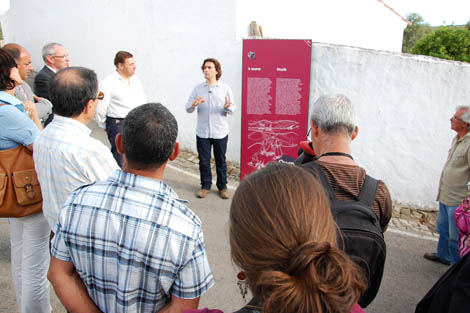 The fragment of the Viemeiro stele, found by José Viegas Gregório in the 60s of the XNUMXth century in this place in the parish of Salir, is, since yesterday, the most recent piece of the Salir Museum, in the interior of the municipality of Loulé.
The fragment of the Viemeiro stele, found by José Viegas Gregório in the 60s of the XNUMXth century in this place in the parish of Salir, is, since yesterday, the most recent piece of the Salir Museum, in the interior of the municipality of Loulé.
Its presentation to the general public culminated the inauguration of the street exhibition on the Writing of the Southwest, this still undeciphered writing of the peoples who inhabited the Algarve and Lower Alentejo mountains in the Iron Age, around 2500 years ago, and which reached the today inscribed in stones – the stelae.
Fortuitous finds, at first, and systematic work by archaeologists, more recently, have been (re)discovering these mysterious “letter stones” that the mountain inhabitants have known for a long time.
The traveling street exhibition «Who writes us from the Serra», which has as its theme the stelae with writing from the Southwest and the Iron Age in the Algarve mountains, can be seen in the streets of Salir, next to the school and up to the Museum Centre, until June 5th. The exhibition will then be presented at Penina-Benafim (June 10th to July 10th) and will end at Ameixial (July 13th to August 18th).
Pedro Barros, one of the archaeologists of the Estela Project, revealed to Sul Informação which also intends to «convince the City of Loulé to then present this exhibition in a city garden».
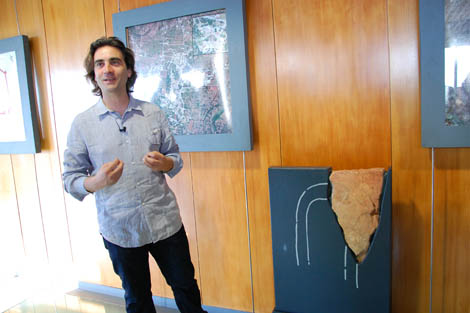 Judging by the enthusiasm of mayor Seruca Emídio, it won't be difficult to convince the municipality. The mayor thanked all the work done by the Estela Project archaeologists – in addition to Pedro Barros, Samuel Melro and Susana Estrela – and by the municipality's technicians and praised the fact that the pure and hard research work is now being shown to the general public.
Judging by the enthusiasm of mayor Seruca Emídio, it won't be difficult to convince the municipality. The mayor thanked all the work done by the Estela Project archaeologists – in addition to Pedro Barros, Samuel Melro and Susana Estrela – and by the municipality's technicians and praised the fact that the pure and hard research work is now being shown to the general public.
The traveling exhibition and the first public presentation of the Viemeiro stela (or Viameiro, or Vimeiro, opinions on the toponym are divided…) took place yesterday, May 9th, Thursday of Espiga and, therefore, day of big and lively popular party in Salir. It was a way to unite the intangible heritage of popular culture with the archaeological heritage, in the end bridging the millennia of history of the same territory.
Due to the music of the Festa da Espiga that could be heard below, in the square in front of the primary school, the first explanations by archaeologist Pedro Barros about the first of the six panels in the street exhibition could barely be heard. There are six panels - on the themes "Iron Age", "Writing of the Southwest", "Life", "Death", "Stelas de Benafim/Salir" and "Stelas do Ameixial" - and give a good overview about what the Southwestern Writing was and how the peoples who produced it lived.
Seruca Emídio, at the small ceremony that took place at the Salir Museum, culminating the exhibition walk along the streets of the village, underlined that the valorization of the Sudoeste Writing and the stelae that support it is «very important to complement the nature and cultural tourism that seeks this area of the county's interior».
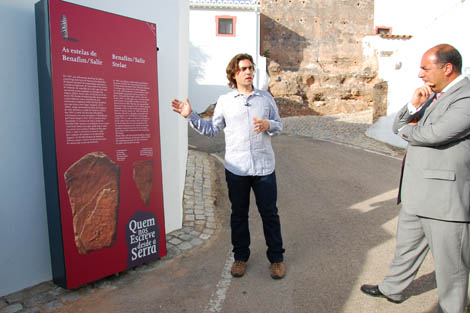 Dália Paulo, regional director of Culture of the Algarve, on the other hand, congratulated the Loulé Council and the Estela Project for having chosen «this day of popular celebration to show this heritage that was hidden». Dália Paula praised the «coherent and consistent» work of the Câmara de Loulé in the areas of archeology and heritage and stressed that «the role of archaeologists is not only excavation and research, but they also have a social function, in their connection with the population and tourism».
Dália Paulo, regional director of Culture of the Algarve, on the other hand, congratulated the Loulé Council and the Estela Project for having chosen «this day of popular celebration to show this heritage that was hidden». Dália Paula praised the «coherent and consistent» work of the Câmara de Loulé in the areas of archeology and heritage and stressed that «the role of archaeologists is not only excavation and research, but they also have a social function, in their connection with the population and tourism».
The contents of the exhibition are succinct and focused on transmitting the main ideas, in a contemporary and creative discourse that satisfies more than one type of visitor, that is, it cuts across age groups, levels of knowledge and degrees of interest.
It was also ensured that the exhibition does not have access and time constraints, providing the visitor with a short visit time. The exhibition is bilingual (Portuguese and English), allowing visitors to understand the contents across borders.
The exhibition is part of a collaboration between the Municipality of Loulé and the Estela Project. This project is concerned with transforming the scientific knowledge acquired in strengthening the identity of people with their heritage and creating with this information a cultural landscape.
What is Southwest Writing
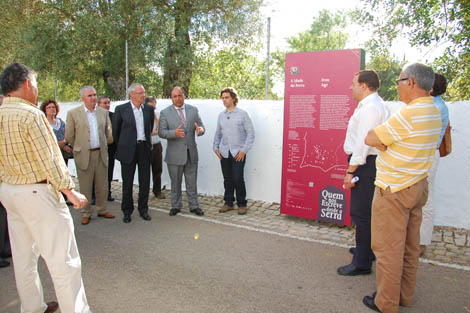 The writing of the Southwest is the oldest written manifestation of the Iberian Peninsula that, even today, is still to be deciphered.
The writing of the Southwest is the oldest written manifestation of the Iberian Peninsula that, even today, is still to be deciphered.
In the Iberian Peninsula, more than 2500 years ago, at a time of great technological innovations and cultural transformations, the peoples of southern Portugal and Andalusia, using the Phoenician alphabet from the Eastern Mediterranean, created a script specific to the language spoken in the region: the writing of the Southwest.
Concentrated in the Algarve mountains, there are few traces of this writing, around a hundred, and most are found on stelae: stone blocks fixed to the ground, where the text was engraved and written in an arch, in the opposite direction to ours: from below to up and from right to left.
It is in this region that authors of Classical Antiquity refer to the existence of especially cultured and developed people. According to Strabo (a Greek historian and geographer from the XNUMXst century AD) “they have a grammar and writings from ancient memory, poems and laws in verse”.
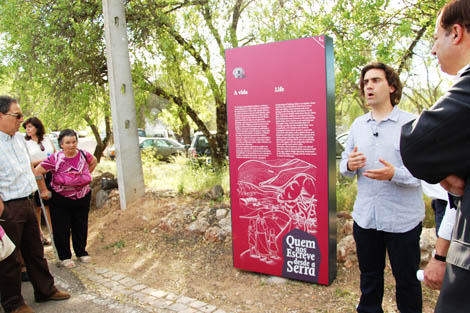 The spatial distribution of the stelae, in the current Portuguese territory, indicates that the mountains of Mú and Caldeirão, between the Algarve and Baixo Alentejo, are one of the epicenters of this phenomenon. Here, two sets can be identified, one to the south, in the transition between the Serra and the Barrocal, between Benafim and Salir, where the stelae of Fazenda das Alagoas, Viameiro and Barradas were found and that with the stelae found in Bensafrim (Lagos) and São Bartolomeu de Messines (Silves) trace the southern limit of the concentration of stelae with writing from the Southwest.
The spatial distribution of the stelae, in the current Portuguese territory, indicates that the mountains of Mú and Caldeirão, between the Algarve and Baixo Alentejo, are one of the epicenters of this phenomenon. Here, two sets can be identified, one to the south, in the transition between the Serra and the Barrocal, between Benafim and Salir, where the stelae of Fazenda das Alagoas, Viameiro and Barradas were found and that with the stelae found in Bensafrim (Lagos) and São Bartolomeu de Messines (Silves) trace the southern limit of the concentration of stelae with writing from the Southwest.
And the other, to the North, around the Vascãozinho, Vascanito and Vascão streams, confirming this site with one of the three main concentrations of this type of epigraphic remains, which includes archaeological sites today located in Loulé and Almodôvar.
The first fragment of a stele with writing from the Southwest of the Municipality of Loulé was found in 1897. More than a hundred years later, the identification of these epigraphic monuments is due to the precious contribution of countless Loulés, researchers and lovers of archeology, such as the Prior de Salir, José Rosa Madeira, José Viegas Gregório, Isilda Martins and Victor Borges.
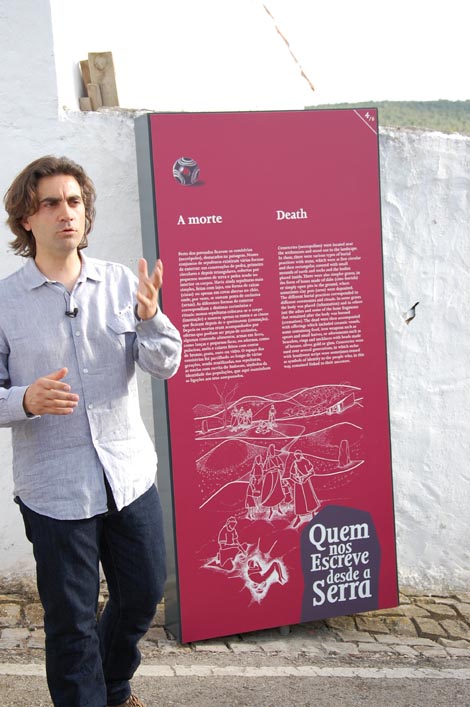 They are also joined by researchers such as Ataíde de Oliveira, José Leite de Vasconcelos, Manuel Gómez de Sosa, Caetano de Mello Beirão, who contributed to the identification of ten stelae divided into the sets of Benafim/Salir and Ameixial and to the investigation of writing of the Southwest.
They are also joined by researchers such as Ataíde de Oliveira, José Leite de Vasconcelos, Manuel Gómez de Sosa, Caetano de Mello Beirão, who contributed to the identification of ten stelae divided into the sets of Benafim/Salir and Ameixial and to the investigation of writing of the Southwest.
Since 2008, there is the Estela Project, which has as its first objective the systematization of information from stelae with writing from the Southwest, through the characterization of the contexts, material culture and territory of archaeological sites in the Algarve and Alentejo mountains, contributing to the review and production of knowledge about the society that lived there, in the middle of the 1st millennium BC.

















Comments